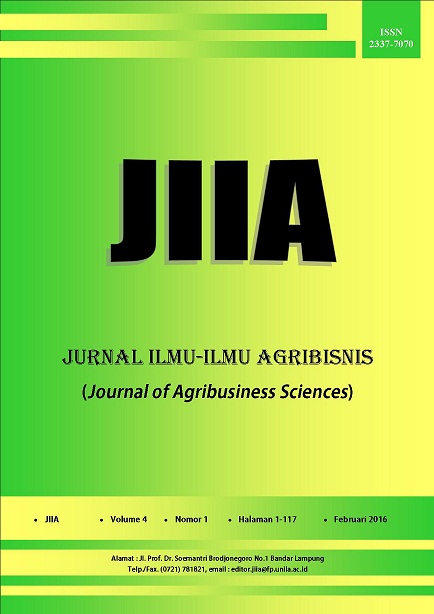PERMINTAAN DAN KEPUASAN RUMAH TANGGA DALAM MENGONSUMSI BERAS SIGER DI PROVINSI LAMPUNG
DOI:
https://doi.org/10.23960/jiia.v4i1.1217 Abstract View: 367
Abstract View: 367
Abstract
The objectives of this research were to analyze the pattern of Siger Rice consumption, factors controlling Siger Rice demand and household satisfaction of Siger Rice in Lampung Province. This research was done in Bandar Lampung and South Lampung. The data was collected in Mei 2015. The technique used for sampling was non probability sampling with 60 respondents. The analysis methods used were descriptive analysis, multiple linear regression, Customer Satisfaction Index (CSI) and Importance Performance Analysis (IPA). The research showed that the househould of KWT Tunas Baru consumed 5,47 kg per month,this was much than the household of KWT Agung Lestari, 2,99 kg per month. It was related to the reason of KWT Tunas Baru respondents (60%) consuming Siger Rice which was for health while KWT Agung Lestari respondents (40%) consuming Siger Rice for their custom. Consumption frequency of Siger Rice by consumerwas 8 to 12 per month. Factors affecting the household demand of Siger Rice in KWT Tunas Baru were the price of paddy rice, the price of fish, and the number of family member, while in KWT Agung Lestari werethe price of paddy rice and the price of fish. The CSI of Siger Rice in KWT Tunas Baru and KWT Agung Lestari were 73,8% and 67,8% there were in satisfied category. According to IPA result, the attribute which had to be the main priority of Siger Rice KWT Tunas Baru and KWT Agung Lestari to be fixed was price.
Key words : consumption pattern, CSI, IPA, Siger Rice
Downloads
Downloads
Published
How to Cite
Issue
Section
License
Authors who publish with this journal agree to the following terms:
Authors retain copyright and grant the journal right of first publication with the work simultaneously licensed under a Creative Commons Attribution License that allows others to share the work with an acknowledgement of the work's authorship and initial publication in this journal.
Authors are able to enter into separate, additional contractual arrangements for the non-exclusive distribution of the journal's published version of the work (e.g., post it to an institutional repository or publish it in a book), with an acknowledgement of its initial publication in this journal.
Authors are permitted and encouraged to post their work online (e.g., in institutional repositories or on their website) prior to and during the submission process, as it can lead to productive exchanges, as well as earlier and greater citation of published work (See The Effect of Open Access).














